Winter Flowering Shrubs Add Beauty, Color and Fragrance to Your Garden
Winter flowering shrubs are a boon to the winter-weary gardener who longs for spring. Carefully chosen and sited (depending on your climate) it is possible to enjoy color and fragrance most months of the year.
There are many ways to utilize winter flowering shrubs in the garden. They can be interspersed through a shrub border quietly waiting for their time to shine. They can be used as specimens such as Camellia japonica. Camellias can also make an excellent evergreen background or hedge.
If space allows, one of the nicest ways to use winter flowering shrubs is to create a winter garden or border. A woodland walk that gets winter sun when the leaves have fallen off is ideal. Imagine filling it with color from camellias, mahonias, witchhazels, and flowering quince; and fragrance from daphnes, wintersweet, edgeworthias, and winter honeysuckle. And then, underplant the shrubbery with hellebores, pansies, cyclamen, evergreen ferns, and add small bulbs like snowdrops, Iris reticulata and winter aconite. And don’t forget to include some small trees or shrubs with colorful bark like coral-bark maple or red-or yellow-twigged dogwood. Such a walk or border is a delight and may become your favorite part of the garden.
Flowering Shrubs for Winter
Camellia japonica, Japanese camellia, Zones 7-9. The most beautiful of the winter flowering shrubs, these queens of the winter/spring garden, depending on cultivar, location and the weather, bloom anywhere from late fall to mid spring in milder parts of the country. C. japonica has larger leaves than C. sasanqua and grows larger overall. Some early season bloomers will sometimes be caught by a late freeze. Colors are white, pale to deep pink, red--even a few yellows--and there are numerous variegated cultivars. 'Rebel Yell' is pictured. Some of the best places in the country to see camellias are the headquarters of the American Camellia Society at Massee Lane Gardens in Fort Valley, Georgia, Norfolk Botanical Gardens in Norfolk,Virginia, the South Carolina Botanical Garden in Clemson, and the Huntington Gardens in Pasadena, California. Click here for more information and pictures of favorite cultivars of Camellia japonica.
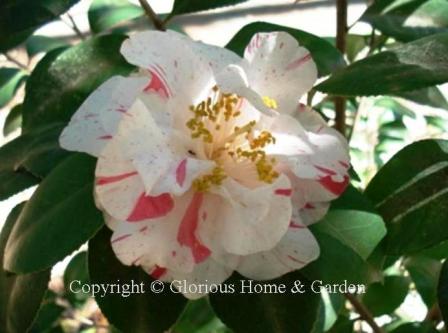 Camellia japonica 'Rebel Yell'
Camellia japonica 'Rebel Yell'Chaenomeles speciosa, flowering quince, Zones 4-8. Flowering quince stands out in the late winter or early spring garden in mostly rather loud coral, orange or red flowers. There are white and double forms also. To me, the prettiest one is 'Toyo-Nishiki' which has white, soft pink and deep pink blooms on the same plant. It has a softer, more refined look. Though for a bolder look, try 'Orange Storm' Plant it where you need a splash of early color, but where it will be unobtrusive the rest of the year perhaps in a mixed shrub border.
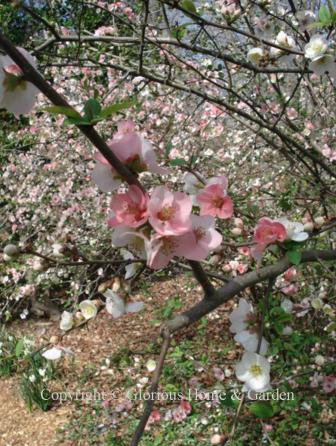 Chaenomeles speciosa 'Toyo-Nishiki'
Chaenomeles speciosa 'Toyo-Nishiki'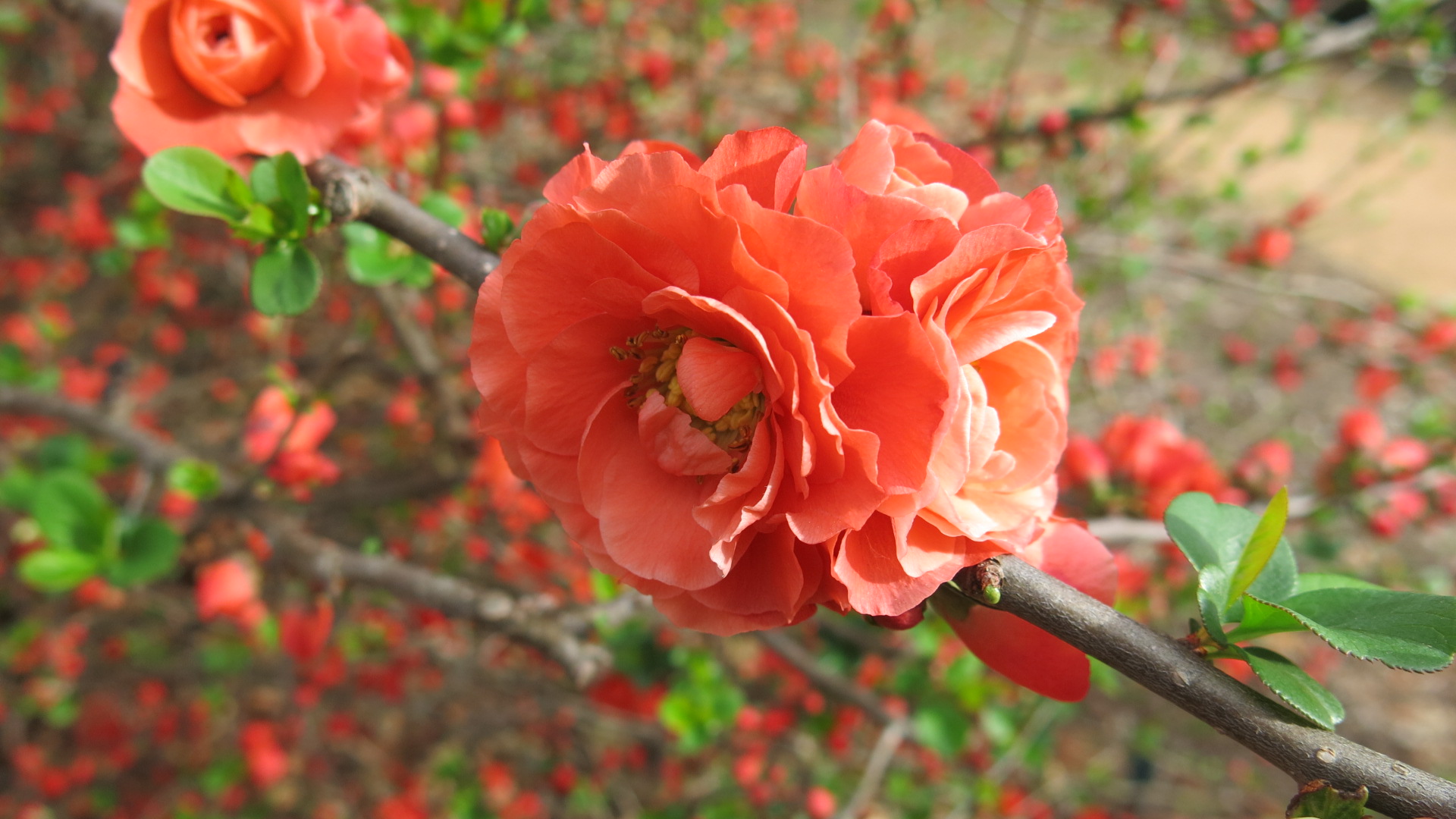 Chaenomeles 'Orange Storm'
Chaenomeles 'Orange Storm'Chimonanthus praecox, fragrant wintersweet, Zones 6-9. I was wandering around the State Botanical Garden in Athens, GA in January and caught a whiff of a delightfully sweet fragrance. I looked around for the source and soon found a deciduous shrub with small waxy yellow flowers with rosy-purple at the base of the interiors. Got to have one! This is an underutilized winter flowering shrub that is lovely in a woodland garden or near the house so you can enjoy the fragrance.
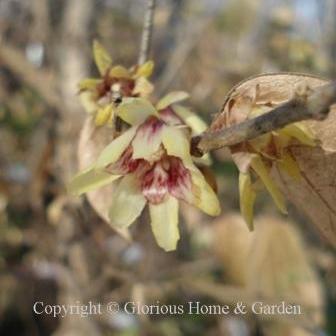 Chimonanthus praecox flowers
Chimonanthus praecox flowersDaphne aurantiaca, Zones 7-9. For collectors, or those seeking the unusual, this yellow-flowered, fragrant daphne from China fills the bill. In the wild it is found on rocky slopes where it gets excellent drainage, so in gardens that is the key to its survival--it must not be sited where it will be subjected to excessive moisture, especially in winter. Small stones or sharp grit must be placed around the stem to keep moisture away.
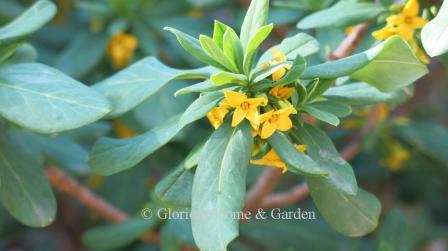 Daphne aurantiaca
Daphne aurantiacaDaphne odora, fragrant daphne, Zones 7-9. One of my favorite winter flowering shrubs. When the buds begin to swell in late February on the daphne I grow in a pot by my back door, I know that spring can't be far off. Luscious fragrance at a time when scent is scarce. 'Aureo-marginata' has leaves edged in pale yellow and purple buds which open to white. There is also a white form, ‘Alba,’ with white flowers and green leaves. Other cultivars include 'Leucanthe' with deep green leaves and pale pink flowers, ‘Mae-jima’ with variegated foliage and white flowers, and 'Rubra' with green leaves and dark pink buds that open to lighter pink. inside.
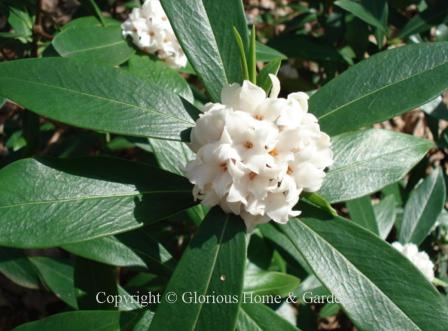 Daphne odora 'Alba'
Daphne odora 'Alba'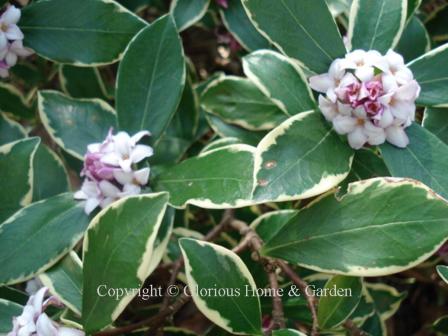 Daphne odora 'Aureo-marginata'
Daphne odora 'Aureo-marginata'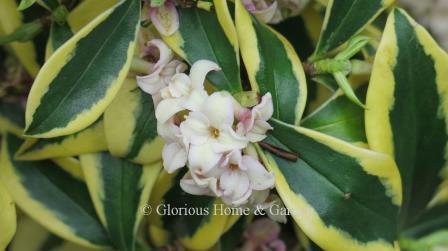 Daphne odora 'Mae-Jima'
Daphne odora 'Mae-Jima'Edgeworthia chrysantha, paperbush, Zones 7-9. This winter
flowering shrub (called mitsumata in Japan) is a novelty, but is striking, and a shrub for all seasons. Paperbush stands out
in the late winter garden as its large white bud clusters open on the
ends of bare stems to reveal yellow pompom flowers that exude a lovely sweet fragrance that can be detected across the garden. The large blue-green leaves are very handsome also all summer, and turn a lovely soft yellow in the fall. Even before the flowers open, the bare stems (which always branch out in 3's) dotted with last year's leaf scars add interest, and terminate with the conspicuous white buds. This fascinating plant hails from China, Japan and Korea, and the bark was used for making a high-quality paper.
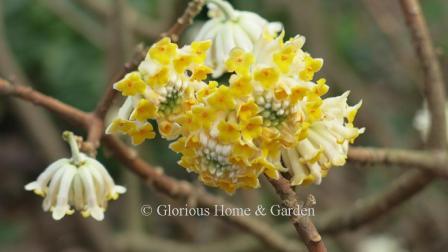 Edgeworthia chrysantha 'Winter Gold'
Edgeworthia chrysantha 'Winter Gold'Erica carnea, winter heath, Zones 5-7. This small evergreen makes a lovely ground cover for northern zones with its winter flowers in colors of white, pink, mauve, purple and red.
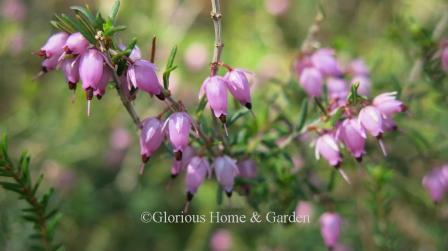 Erica carnea 'Springwood Pink'
Erica carnea 'Springwood Pink'Eriobotrya japonica, loquat, Zones 8-10. The fruit-bearing evergreen winter flowering shrub, or small tree, is unusual in that it flowers in winter. The flowers are fragrant, and the fruit can be used to make jams or jellies.
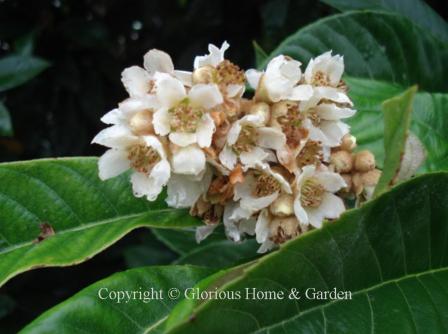 Eriobotrya japonica
Eriobotrya japonicaWitchhazels
Hamamelis mollis, Chinese witchhazel, Zones 5-8. Witchhazels are must-have winter-flowering shrubs. Chinese witchhazel produces fragrant yellow winter flowers on a spreading shrub or small tree. 'Pallida' is pictured.
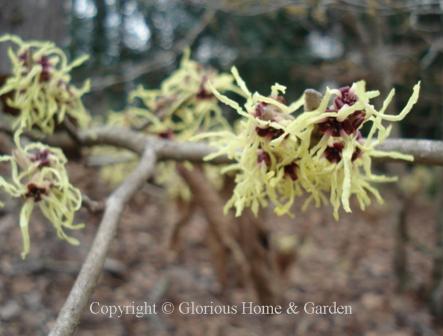 Hamamelis mollis 'Pallida'
Hamamelis mollis 'Pallida'Hamamelis vernalis, vernal witchhazel, Zones 4-8. Vernal witchhazel produces long-lasting fragrant yellow, orange or red winter flowers. Good for fall leaf color also.
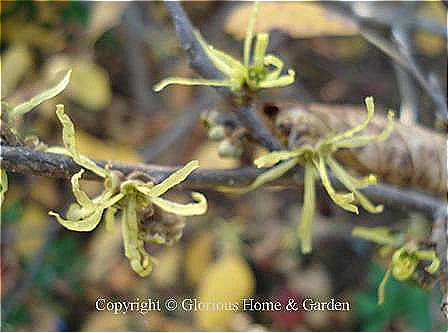 Hamamelis vernalis
Hamamelis vernalisHamamelis X intermedia, hybrid witchhazels, Zones 5-8. These hybrids are crosses between H. mollis and H. japonica. Some of the best are 'Arnold Promise' with yellow flowers, 'Diane' with orange-red flowers, and 'Jelena' with interesting flowers that graduate from red at the base to yellow at the tips of long, twisted petals. '
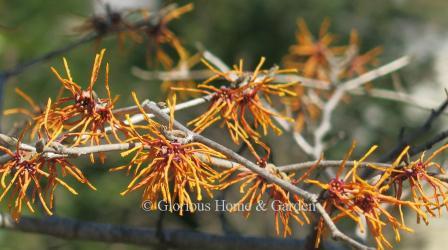 Hamamelis x intermedia 'Aphrodite'
Hamamelis x intermedia 'Aphrodite'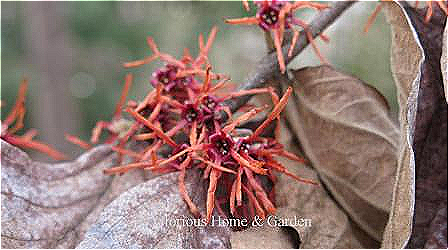 Hamamelis x intermedia 'Diane'
Hamamelis x intermedia 'Diane'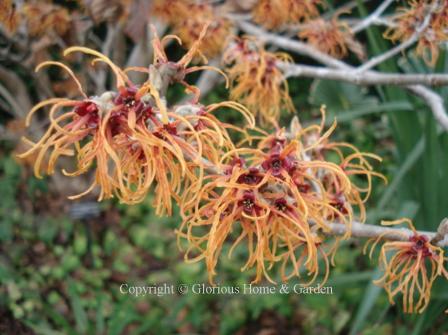 Hamamelis x intermedia 'Jelena'
Hamamelis x intermedia 'Jelena'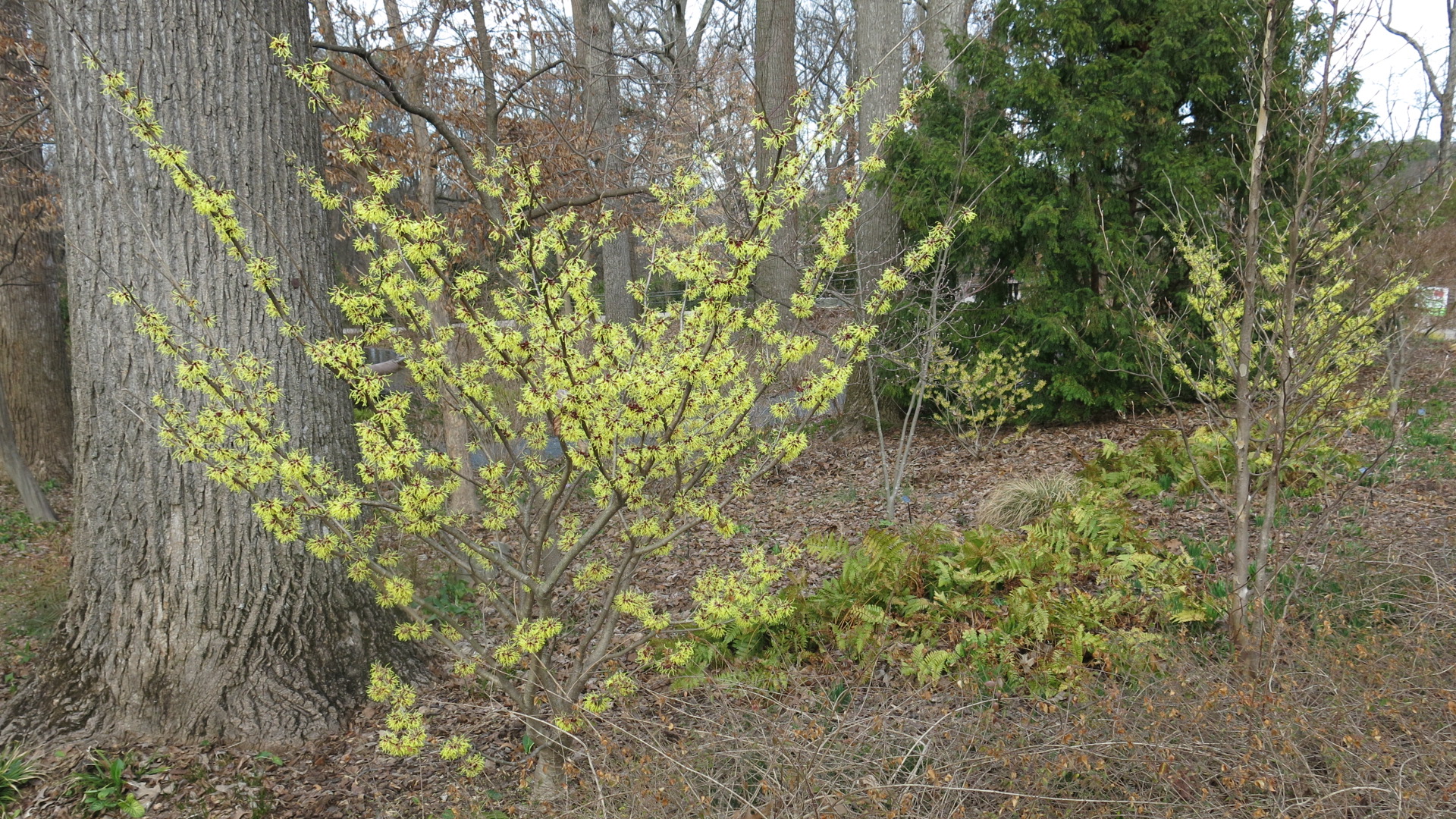 Hamamelis x intermedia 'Primavera'
Hamamelis x intermedia 'Primavera'Jasminum nudiflorum, winter jasmine, Zones 6-10. Bright yellow flowers pop out of slender green branches at the first hint of warmth. Unfortunately, it is not fragrant, but very welcome nonetheless for a flash of color when everything is brown and gray.
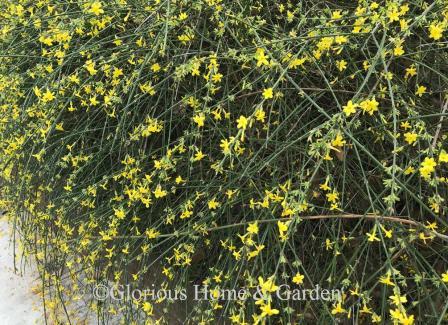 Jasminum nudiflorum
Jasminum nudiflorumLindera obtusiloba, Japanese spicebush, Zones 6-9. Small greenish-yellow flowers occur in late winter on the bare-stemmed branches followed by red-changing to black-fruits. Grows well in shady conditions and is excellent for brilliant yellow fall leaf color as well.
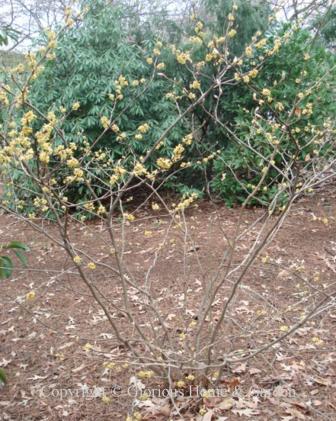 Lindera obtusiloba
Lindera obtusilobaLonicera fragrantissima, winter honeysuckle, Zones 4-8. Unlike the viney types of honeysuckle, fragrant winter honeysuckle is a winter flowering shrub that resembles a snowstorm when in full bloom. The individual flowers are tiny, but en masse they pack a fragrant punch in late winter. Nice for a screen or hedge especially against a darker background where they can stand out. This is one of those shrubs, like forsythia, that look much better and more graceful with their natural arching branches rather than pruned in stiff formal shapes. They can be pruned back severely after flowering to rejuvenate when necessary.
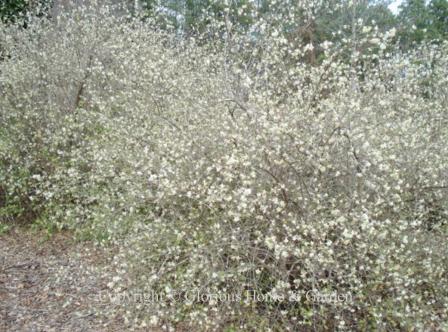 Lonicera fragrantissima
Lonicera fragrantissimaMahonia bealei, leatherleaf mahonia, Zones 6-9. Sprays of
yellow flowers occur in winter to early spring on this winter flowering
evergreen shrub with spiny holly-like leaves followed by oblong blue
berries that birds love. Fragrant, too!
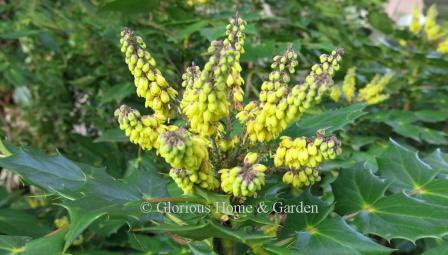 Mahonia bealei
Mahonia bealeiMahonia x media ‘Marvel,’ hybrid mahonia, Zones 6-9. Another interesting mahonia introduction, ‘Marvel,’ also from the Southern Living Plant Collection, grows larger to about 6’ tall and 4’ wide, with wider leaves, and unlike ‘Soft Caress,’ each leaf is tipped with a sharp point. The branches grow in tiers around the plant topped in winter with bright yellow sprays of flowers followed by blue berries.
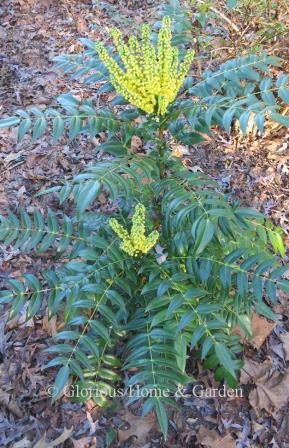 Mahonia x media 'Marvel'
Mahonia x media 'Marvel'Rosmarinus officinalis, rosemary, Zones 6-8. We don't often think of rosemary as a flowering shrub, but it has surprising flowers that adorn the plant in winter. Some cultivars have deep to pale blue flowers, others have lilac or pink. Rosemary is charming to grow in the garden or in containers for the convenience of snipping off fresh sprigs of the aromatic leaves for cooking.
 Rosmarinus officinalis
Rosmarinus officinalisSarcococca confusa, sweetbox, Zones 6b-8. Similar to S. hookeriana, but said to be more fragrant, this evergreen would be a good choice for massing. The flowers are small and rather inconspicuous, but highly fragrant.
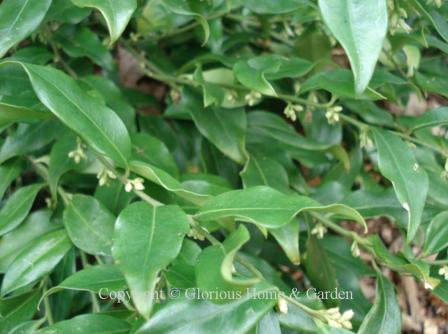 Sarcococca confusa
Sarcococca confusaSarcococca hookeriana, sweetbox, Zones 6-8. Evergreen leaves with green stems make this a good choice for winter color for a border or ground cover. The fragrant flowers are tiny and hidden, but exude a lovely fragrance in late winter and early spring.
Sycopsis sinensis, Chinese fig hazel, Zones 7-9. A member of the witchhazel family, the Chinese fig hazel is a winter flowering evergreen shrub that produces small yellow flowers in winter with predominate reddish stamens. A good choice for warmer climates.
Viburnum tinus, laurustinus, Zones 8-10. An evergreen species with pink buds that open to white flowers in winter. This winter flowering shrub makes an excellent hedge or screen in the warmer climate zones.
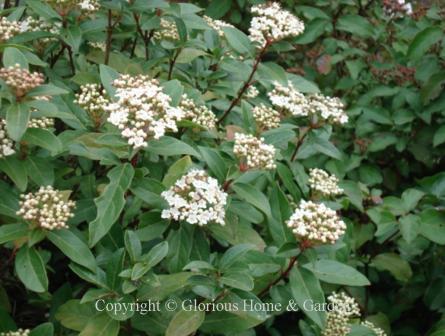 Viburnum tinus
Viburnum tinusPlant of the Month
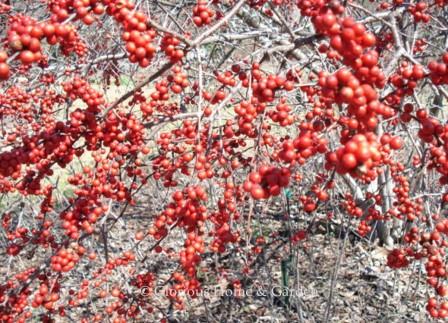
Ilex verticillata
Winterberry holly
Updated new USDA Plant Hardiness Zone Map 2023.